|
<< Click to Display Table of Contents >> Creating and Editing Compound Supersequences |
  
|
|
<< Click to Display Table of Contents >> Creating and Editing Compound Supersequences |
  
|
Using the procedures described in the previous topic Creating Staged Excavations for Sequential Strips,once set up of Staged Excavations for each strip is complete the will be design file with the following characteristics:
•A staged excavations for each strip with Raw Sequence and Subsequences.
•A set of Component Supersequence is for each Pass or independent part of each Strip.
•The topography will be in the starting state for the design.
•The Material Logs will be at zero.
The following description assumes the 3d-DigPlus design file will be at the state described above. With this state of set up the process of assembling a Supersequence for multiple strips consists of arranging the pre-existing Component Supersequences into the appropriate order in a Compound Supersequence.
The procedure involves the following steps:
1.For each strip, establish the required state of the pit on completion of this strip. That is determined the advanced stripping that will be completed at that point went each strip is complete.
2.Using (1) determine, for each strip, which Component Supersequences need to be complete for advance strips at that point when that current strip is complete.
3.Using (1) and (2), create the required Compound Supersequence.
The most simple form of Supersequence consists of a single branch. The following diagram illustrates such a Supersequence:
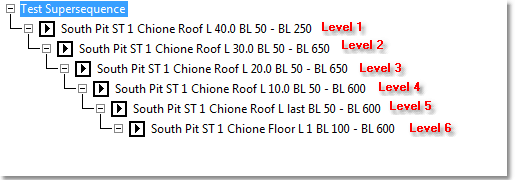
The Supersequence branch consists of contiguous list of Subsequences, with each Subsequence on a particular Level.
When a single branch Supersequence is executed the execution follows the following order:
•The first Block (Step) of the first Subsequence is excavated.
•The following Blocks of the first Subsequence are excavated in order until the Subsequence is complete.
•The next Subsequence in the Supersequence is executed in the above manner and the process repeats until Supersequence is complete.
The above order of execution is the only logical order possible given the structure of the single branch. Complex Supersequences typically have multiple Branches. The following figure illustrates a small two branch Supersequence:
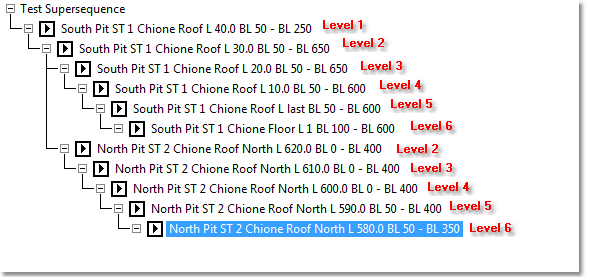
Note that the second branch starts at level 2 on the first branch, the first Subsequence of the second branch is also at level 2, the following Subsequences in the two branches increment with levels in step as can be seen in the diagram above. When parallel branches exists there is generally one Subsequence at each level for each branch. So in the above example the second branch starts at Level 2 and both branches have a Subsequence located on Level 2. The same applies to all subsequent levels.
When a Supersequence has two branches in parallel these parallel branches imply operations which take place simultaneously.
When a multi- branch Supersequence is used in a full truck shovel simulation each branch will typically have its own equipment fleet assigned. In this situation the time required to excavate each Block of each Subsequence in each branch will be determined and this timing will be used to keep the multiple branch operations in chronological order.
At this stage we are dealing with modelling of excavation and dump only and consequently no timing information exists. However by using the options which control the order of block excavation it is usually possible to create a simulation in which parallel branches of a Supersequence are executed in a manner which approximately reflects the rate of excavation of the parallel branches in the field.
When either Excavate/Start Supersequence or Simulate/Run Supersequence commands are executed the Run Supersequence Options dialog will be produced:
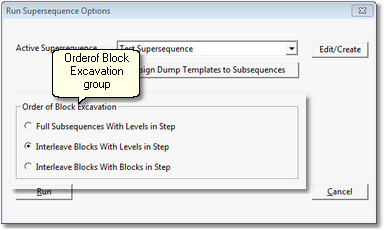
In this dialog box there is the Order of Block excavation group. The three block ordering options are:
Full Sub Sequences with Levels in Step. This is the default option. When the execution of Supersequence encounters the first node (point where two branches join) the following procedure is applied:
•The node-level Subsequence (level 2 in the figure above) on the main branch is executed to completion.
•The node-level Subsequence on the secondary branch is executed to completion.
•The Subsequence at the next level in the main branch is executed to completion.
•The Subsequence at the same level in the secondary branch is executed to completion.
•This procedure continues for the remainder of the Supersequence.
Interleave Blocks With Levels in Step. A Subsequence consists of contiguous set of Blocks (Steps). This option treats each Block like a sub level in the Supersequence,and keeps these sub levels in step. Two parallel Subsequences will not typically contain the same number of Blocks. In this option the execution of parallel blocks in the two parallel Subsequences progresses in a manner that attempts to evenly distribute the execution of the parallel blocks. Consider the case of two parallel Subsequences, Subsequence A and Subsequence B. Subsequence A has twice as many blocks as Subsequence B. When these two Subsequences are excavated in parallel, two blocks of Subsequence A will be executed for every one block of Subsequence B. In situations where two parallel Subsequences have Block counts which are not multiples, the system will adjust the execution in an irregular manner to ensure that both Subsequences are fully excavated as part of the same Level (i.e. both Subsequences will be complete before Supersequence execution moves to the next level).
Interleave Blocks with Blocks in Step. This option treats Subsequence blocks as an absolute level. When the execution of the Supersequence encounters the first node the following procedure is applied:
•The first block of the node level Supersequence in the main branch is excavated.
•The first block of the node level Supersequence in the secondary branch is excavated.
•The second block of the node level Supersequence in the main branch is excavated.
•The second block of the node level Supersequence in the secondary branch is excavated.
•The above procedure repeats throughout the entire Supersequence.
Note that in this last option levels in the main Supersequence are not used to coordinate parallel branches. In the first two options all Subsequences in a Supersequence will be completed before execution of the Supersequence proceeds to the next level. In this last option this level coordination does not apply and execution simply proceeds block on block across branches.
The above options can be illustrated by a simple example. Consider a two branch Supersequence, with branch A and branch B. Both branches contain four Subsequences. Each Subsequence in branch a contains 40 blocks and each Subsequence in branch B contains 20 blocks. When this Supersequence is executed the following will occur:
Interleave Blocks With Levels in Step. Two blocks of each Subsequence in branch A will be excavated for every one block of each Subsequence in branch B. As a result corresponding levels in the two branches will complete at the same time, and as the two branches have the same number of Subsequences each branch will complete at the same time.
Interleave Blocks with Blocks in Step. One Block of branch A will be excavated for every one block of branch B. As branch B has half as many blocks as branch A, branch B will be complete at a point when only half of branch A is complete. consequently the second half of branch A will complete after branch B is finished.
Key Information - Compound Supersequences and order of excavation.
 The above description applies to Basic Supersequences, that is Supersequences consisting of a list of Subsequences. There are also Compound Supersequences which consist of a list of other Component Supersequences. When an existing Supersequence is included as a component in a Compound Supersequence is just shorthand for the Basic Supersequence it contains. These Component Supersequence is can be expanded into their Basic form in the Supersequence Editor.The above ordering principles apply to the fully expanded form of the Compound Supersequence, that is to say the equivalent Basic Supersequence.
The above description applies to Basic Supersequences, that is Supersequences consisting of a list of Subsequences. There are also Compound Supersequences which consist of a list of other Component Supersequences. When an existing Supersequence is included as a component in a Compound Supersequence is just shorthand for the Basic Supersequence it contains. These Component Supersequence is can be expanded into their Basic form in the Supersequence Editor.The above ordering principles apply to the fully expanded form of the Compound Supersequence, that is to say the equivalent Basic Supersequence.
The use of the above methods will be demonstrated using an example pit. This pit has three coal seams, Ate, Boreas and Chione, with Ate being the top seam and Chione the lowest. there are six Strips in the pit.
The following diagram illustrates the sample pit:
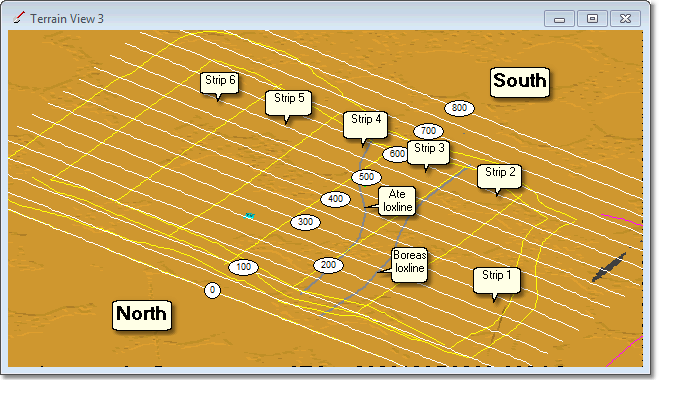
In Strip 1 only the Chione seam is viable. In the above figure the loxlines for Ate and Boreas seams. the Boreas seam is viable in Strip 2 and in Strip 3 all Three seams are viable.
The desired states of the pit are as follows:
Strip 1 complete - Strip 2 Boreas coal pass complete.
Strip 2 complete - Strip 3 Boreas coal pass complete - Strip 4 Ate coal pass complete.
The relative state of advance that exists when Strip 2 is complete is progressed for the remainder of the strips, until the various passes terminate at the Strip 6 final high wall.
In addition to the above it is necessary that: covering be divided between the North and the South ends of each strip. Coal uncovery in the North is to take place while the last lift of waste is being removed in the South. In order to meet this condition there needs to be Subsequences for North and South ends of each strip.
The mining is to be conducted with two fleets. One excavator and truck fleet will be dedicated to the Boreas and Chione waste removal. A separate fleet will pre-strip Ate waste and coal.
In order to achieve the separation of coaling operations in the north and south of the pit, as described above, there must be separate Subsequences from the North and South of the strip for the final waste passes and the coal. To achieve these requirements sub sequences must be created as follows:
•Non-final waste passes can be modelled with a single Subsequence extending to the full length of the strip.
•Final waste passes must be modelled with two Subsequences, one for the north (blocks 0 to 350 and one for the south (blocks 400 to 650+).
•Coal passes must be modelled with two Subsequences, one for the north (blocks 0 to 350 and one for the south (blocks 400 to 650+).
Subsequence strategy
The figure below illustrates this Subsequence strategy:
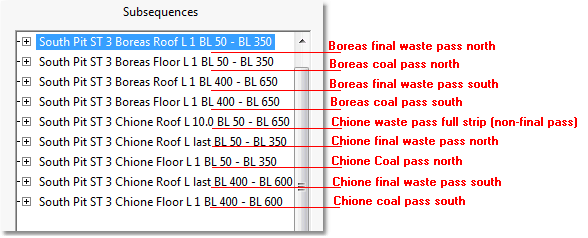
In order to achieve the desired states at completion of each strip (as described above) a Component Supersequence is required for the combined waste and coal passes for each seam mined in each strip.
Component Supersequence strategy, steady state pit conditions
From strip 3 onwards all seams a viable and the advanced stripping is steady state. The sate when strip 'n' is complete consists of:
Strip n complete.
Strip n+1 Boreas pass complete.
Strip n+2 Ate complete.
The following figures illustrate the three Component Supersequences required (one for each coal seam mined):
Ate coal Component Supersequence:

Boreas coal Component Supersequence:

Chione coal Component Supersequence:

Component Supersequence strategy, transitionary pit conditions
Once the pit reaches steady-state conditions, as described above, the key states at the end of each strip can easily be described by completed passes in the advanced strips. However in the initial stages of excavating the pit, such as the boxcut excavation, further subdivision beyond the main passes is required.
the required state on completion of strip one (boxcut) is:
Strip 1 complete
Strip 2 Boreas coal pass complete.
Building a Component Supersequence for the complete stripping in strip 1 and another for strip 2 to the point of completion of the Boreas coal pass, would be sufficient to generate the above state. However this would require the Strip 1 Component Subsequence to be run followed by the Component Subsequence for the Boreas pass of strip 2. This arrangement would complete Strip 1 then follow this with the excavation of Strip 2 to the Boreas coal floor. However we require these two operations to take place simultaneously.
Designing a sub sequence to meet these requirements requires consideration of the excavation of lifts within the various passes for the transitionary strips. In this example pit there are 5 lifts in the Chione waste pass in strip 1. Strip 2 waste stripping will commence when the strip 1 Chione waste pass 30m offset lift (second lift) is complete. Strip 1 will therefore require two Component Supersequences, one to excavate to the point of completion of the Chione waste pass 30m offset lift , and one for the balance of the strip 1 stripping.
The following figures illustrate these Component Supersequences.
Stripping to completion of strip 1 Chione waste pass 580 RL lift:

Stripping to completion of strip 1:

Splitting strip 1 into the above Component Supersequences will allow the final Compound Supersequence to start the strip 2 aureus stripping when the first Component Supersequence for strip 1 is complete. The following section illustrates this.
Supersequence strategy
As mentioned earlier in this topic, when a Supersequence is used as part of a full truck and shovel simulation the rate of advance of individual sub sequences and Component Supersequences will be determined by the calculated fleet productivity. In this example where we are not doing a full simulation the structure of the Supersequence will attempt to approximate the relative advance of the various fleets. In order to achieve this approximation the following principles will be applied when assembling the Supersequence.
•The structure of the Supersequence will ensure that the pit states, as described above, on for completion of particular strips will be met.
•As one fleet will be dedicated to Ate, and the second to Boreas – Chione, once the stripping has reached the state when all three seams are exposed (strip1 Chione complete, strip 2 Boreas complete, strip 3 Ate complete) the Ate stripping and coal will take place in a parallel branch to the Boreas - Chione stripping and coal. this will result in the Ate stripping for strip n+3 taking place in parallel with the stripping for Boreas strip n+2 and Chione strip n.
Once all necessary Component Supersequences have been created, the main Supersequence can be assembled from these as a Compound Supersequence. In the example used here we have created a Component Supersequence for each seam mined in each strip. These are then assembled into a Supersequence designed to achieve the required advanced stripping on completion of each strip.
The strategy for assembling the Compound Supersequence is to create a main branch which excavates the lower passes, and have branches added at appropriate nodes to excavate the advanced stripping upper passes in parallel with the final passes.
The figure below shows the Compound Supersequence for strip 1 and advanced stripping to Boreas coal in strip 2, this operation excavates strip one to the 580 RL lift with one fleet, following this the strip 2 Boreas waste, and strip 1 final lifts are excavated in parallel:

The video clip below shows the above Supersequence being excavated:
The figure below shows the complete Compound Supersequence for the pit:
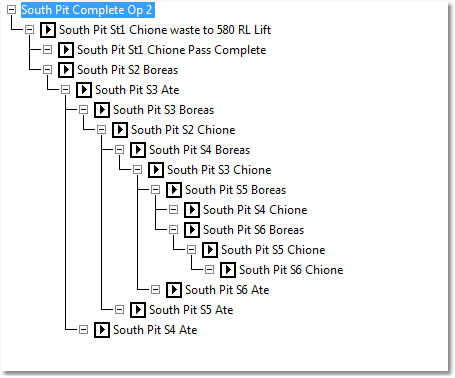
The following video clip shows the excavation of the complete pit:
Tree Group. The Tree Group is a group of buttons for manipulating the Active Supersequence.it consists of the following buttons:
Remove. clicking the Remove button removes the Subsequence which is currently the focus in the Active Supersequence.
Cut. Clicking the Cut button cuts out all Subsequences in the Active Supersequence at the level of the focus, and all Subsequences in the branch below. Cut Subsequences are stored in the clipboard
Paste. Clicking the Paste button pastes all Subsequences in the clipboard. The position and manner in which these Subsequences are added follow the same rules as for the Add Subsequences button.
Pause. Clicking the Pause button inserts a Pause Point into the Supersequence at the current focus point. Pause Points are indicated by pause mark at that level in the Supersequence. This causes the Supersequence to pause during Excavate/Start Supersequence and Simulate/Run Supersequence operations.
Expand. See Creating and Editing Compound Supersequences.